A nostalgically-fuelled fad in men’s fashions which surfaced after 1945 led to an Edwardian dandy style becoming fashionable. The style was known as Edwardian but we can call it the New- or Neo-Edwardian fad, if only to distinguish it from the original Edwardian style of around 1905. The style caught on in some of the richer bohemian circles in London and was associated with snobbish social attitudes reminiscent of the stark social divide that was unquestioned in Edwardian times, in those ‘happy’ days before Britain lost its world-leading position as an Empire. It also caught on in bohemian homosexual circles.
As early as 1950, Harper’s Bazaar proclaimed ‘The return of the beau’ as moneyed ex-guardsmen centred on the ‘row’ to order a style known as the New Edwardian, a name that, according to social anthropologist Ted Polhemus, ‘served to symbolize a time when the greatness of Britain was beyond dispute and to put a check on the increasing cultural hegemony of the United States.’ Led by the example of Cecil Beaton and designer Hardy Amies’ right hand man, Bunny Rogers, the New-Edwardian style was, as author and performer George Melly says in his pioneering tome Revolt into Style, ‘a fair symbol of class privilege.’ Indeed, many a toff ‘ex-guardsmen’ sauntered up to the Row and followed suit, ordering outfits that were the complete antithesis of the drab, post-war Demob issue, and ipso facto became the uniform of the post-war gay man. As Richard Walker says in The Savile Row Story, ‘The outfit featured slightly flared jacket, natural shoulders, slim waist, tight sleeves and narrow trousers; a curly brimmed bowler set atop a longer hairstyle and long, slim, single-breasted overcoat with velvet collar and cuffs completed the look.’
< http://voyagesextraordinaires.blogspot.ie/2012/07/edwardian-fashion-of-space-age.html >
There is something so satisfyingly elegant about the New Edwardian suit, that aristocratic fad that hit the streets of Mayfair and Chelsea in the late 1940s and early 1950s. A revivalist fad among ex-guardsmen, aristocratic loafers and interior designers, its wasp-waisted outline set itself against the baggy hang of the demob suits that served for the majority of the male UK population. The style’s accessories – bowler hat, polished shoes and umbrella – provided regimental glamour, while velvet collars, embroidered waistcoats, ticket pockets and covered buttons recalled the bonhomie of racetrack and music hall: suit as fancy dress. [Guardian 23.Mar.2016]
- curve-rimmed bowler hats
- umbrella as necessary accessory
BUNNY ROGERS, homosexual couturier
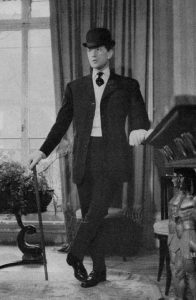
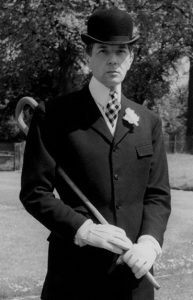
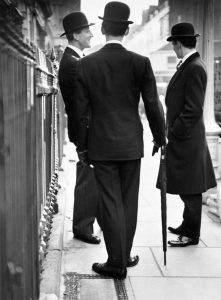
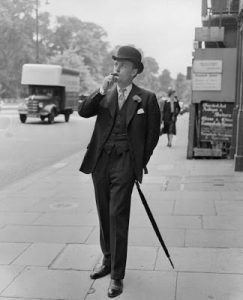
The Bunny Rogers New-Edwardian was portrayed almost exactly (more often than not a with velvet collar) in the person of John Steed (Patrick Macnee) from 1962 onwards in the 1960s television series ‘The Avengers’.
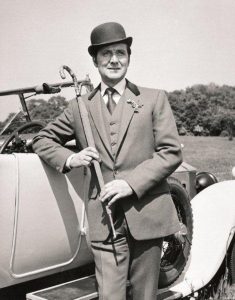

According to the book Reading between Designs by Piers D. Britton and Simon J. Barker, Macnee designed his own suits with the help of tailor Bailey and Weatherill of Regent Street. Steed’s signature style made its way in various forms throughout all the seasons of The Avengers and The New Avengers. He said: ‘I like the idea of velvet for the collars, it helps mould and complement the suits. There are no breast pockets and only one button to give the best moulding to the chest. Plus a deliberately low waist, to give the effect of simplicity, but with an individual style.’ < www.bondsuits.com/the-avengers-steeds-signature-suit/ >
The New-Edwardian style which had made such an impact in richer bohemian circles soon acquired favour among more fashion-conscious men from poorer backgrounds who also aspired to look posh, monied, comfortable as well as noticeable. One of the clearest depictions of the transition is Colin Donellan whose photos appeared in October 1953. That said, Donellan’s style shows three marked differences from Bunny Rogers’s New-Edwardian: firstly, gone is the bowler hat so that young men’s hair can take a more prominent position; secondly, the umbrella is also jettisoned; and thirdly, the jacket is kept open to highlight the waistcoat (the New-Edwardian jacket had more buttons than that of the teddy boy and closed much higher up although complemented by a high Edwardian collar, the tendency was for the waistcoat to open lower among the teds and even be dispensed with). All-in-all the buttoned-up New-Edwardian look becomes the looser teddy boy style.
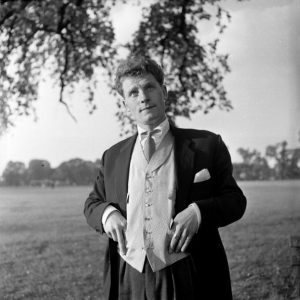
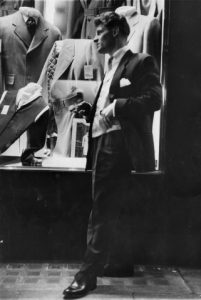
Cecil Gee was originally in Charing Cross Rd before moving to Shaftesbury Avenue.
Peter Frame 2011
Wally Whyton “I spent a lot of time wandering around the West End. There was a wonderful clothes shop in Charing Cross Road called Cecil Gee’s. It later became huge and moved to Shaftesbury Avenue [by late 50s], but in the late forties, it was very small, very modern and very cool. It sold all the current American fashions – and that’s what you
The company was founded in London’s Charing Cross Road in 1929 by Cecil Gee, who quickly revealed himself to be one of the country’s most innovative men’s clothing specialist. Success followed success with the Jacket Shirt in the 1930s, and later with the ‘demob suit’ for the returning soldiers of World War Two. Another Cecil Gee success came in the 1950s when he recognised that by importing fabrics, he was able to provide suits which could be more lightweight, comfortable and versatile.
the man born Sasha Goldstein in Lithuania in 1903. He came here aged 10 and transmogrified into Cecil Gee, inventor, innovator, stylist, godfather,
In his first shop in Commercial Road in the East End in the late 1920s, when he was in his 20s, he was already doing revolutionary things. Hard to credit now, but he was the first to sell shirts with attached collars and he invented the button-through shirt. Before that, all shirts were pulled over your head, nightshirt style. He was the first to put clothes on rails inside a shop rather than having them piled on shelves.
He understood better than anybody the springs of fashion desire. Savile Row was about being posh, Burton was about being respectable, Cecil Gee was about falling in love. After the war, the years of demob drabness, Cecil Gee went American, bringing a sexy whiff of Hollywood into the London smog. Wide-shouldered, double-breasted suits, hand-painted ties. “Forget the Blitz, here comes the Ritz” he said. The Zoot Suit, very flash, was an assault on English uptightness. And, later, when people took against it – too much, too spivy – he took a turn that signalled the start of modern, and Mod times. He went Italian: box jackets, lovely coloured knitwear, pointed shoes. A whole new wardrobe of pleasure.
Modfather, progenitor of the whole modern era of style in Britain.Born Meshe David Osinsky in Lithuania in 1885, Montague Burton came to England in 1900 and, after trading for a couple of years as a pedlar, opened his first shop in Chesterfield
< www.thejc.com/tailor-made-for-a-fashion-revolution-1.64148 >
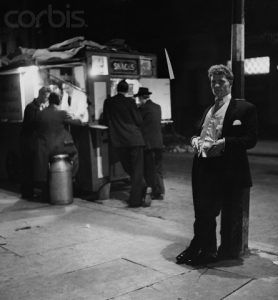
Colin Donellan, aged 22, is a London boy from a good family background but has been in trouble with the police since the age of eight. He has been to a succession of approved schools, Borstals and an adult prison. He is seen here in his ‘Teddy Boy’ clothes, so called because they are influenced by Edwardian fashions; these clothes are worn by many criminal gang members.
Many authors have pointed out that the New-Edwardian fashion stopped rather suddenly as soon as it was acquiring favour among poorer sections of society. The fashion that had been pushed so successfully by the Saville-row tailors that it then became the uniform of the dance hall dandies: ‘It means,’ explained a disconsolate young ex-Guard over a champagne cocktail, ‘that absolutely the whole of one’s wardrobe immediately becomes unwearable.’ As the style became more widespread it acquired a debased popular form among the newly emergent ‘teddy boys’ who were already westernising the style with gamblers ties inspired by western movies. The co-existence of the proletarian teddy boys and upper class New-Edwardians seems to have been short, but it is captured in the following cartoon from the 1950s which plays on the common origin of the clothing and designation of both fashion groups:
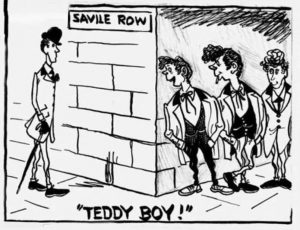
The exact way the teddy boy style of 1954 evolved from the New Edwardian style of 1950 is not well known. This picture of a New Edwardian from around 1952 taken from behind shows that if you make allowances for the bowler hat and the umbrella the styles have much in common, all the more so when you can compare with the dress-style of the oncoming man on the left.

POSTED December 2017.
Post Comment